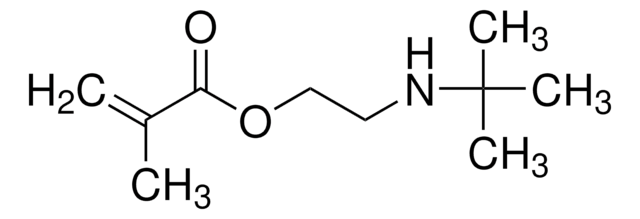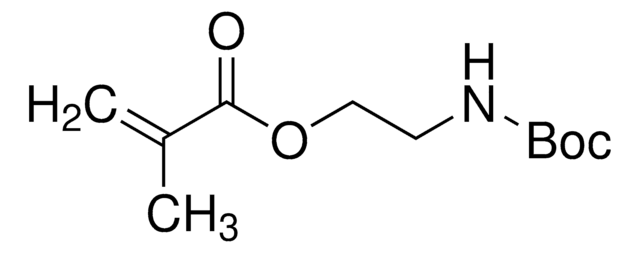408980
2-(Diethylamino)ethyl methacrylate
contains 1500 ppm MEHQ as inhibitor, 99%
Sinónimos:
β-(Diethylamino)ethyl methacrylate, 2-(N ,N -Diethylamino)ethyl methacrylate
About This Item
Productos recomendados
Análisis
99%
formulario
liquid
contiene
1500 ppm MEHQ as inhibitor
índice de refracción
n20/D 1.444 (lit.)
bp
80 °C/10 mmHg (lit.)
densidad
0.922 g/mL at 25 °C (lit.)
cadena SMILES
CCN(CC)CCOC(=O)C(C)=C
InChI
1S/C10H19NO2/c1-5-11(6-2)7-8-13-10(12)9(3)4/h3,5-8H2,1-2,4H3
Clave InChI
SJIXRGNQPBQWMK-UHFFFAOYSA-N
Aplicación
- Polymeric mediator containing ferrocene moieties which are applicable in electrochemical biosensors.
- Sepiolite-based nanocomposites by (cryo)polymerization method.
- Thermoresponsive triblock copolymers via group transfer polymerization (GTP).
Palabra de señalización
Warning
Frases de peligro
Consejos de prudencia
Clasificaciones de peligro
Acute Tox. 4 Inhalation - Eye Irrit. 2 - Skin Irrit. 2 - Skin Sens. 1
Código de clase de almacenamiento
10 - Combustible liquids
Clase de riesgo para el agua (WGK)
WGK 1
Punto de inflamabilidad (°F)
170.6 °F - closed cup
Punto de inflamabilidad (°C)
77 °C - closed cup
Equipo de protección personal
Eyeshields, Faceshields, Gloves, type ABEK (EN14387) respirator filter
Certificados de análisis (COA)
Busque Certificados de análisis (COA) introduciendo el número de lote del producto. Los números de lote se encuentran en la etiqueta del producto después de las palabras «Lot» o «Batch»
¿Ya tiene este producto?
Encuentre la documentación para los productos que ha comprado recientemente en la Biblioteca de documentos.
Los clientes también vieron
Nuestro equipo de científicos tiene experiencia en todas las áreas de investigación: Ciencias de la vida, Ciencia de los materiales, Síntesis química, Cromatografía, Analítica y muchas otras.
Póngase en contacto con el Servicio técnico
![N-[3-(Dimethylamino)propyl]methacrylamide 99%, contains MEHQ as inhibitor](/deepweb/assets/sigmaaldrich/product/structures/295/145/6b4aae15-7cb5-4b7b-9c06-8e6d24e50951/640/6b4aae15-7cb5-4b7b-9c06-8e6d24e50951.png)


![[2-(Methacryloyloxy)ethyl]trimethylammonium chloride solution 75 wt. % in H2O](/deepweb/assets/sigmaaldrich/product/structures/316/612/66b0f4cf-d060-427d-b4f5-e8fab3e5cffe/640/66b0f4cf-d060-427d-b4f5-e8fab3e5cffe.png)



![[2-(Methacryloyloxy)ethyl]dimethyl-(3-sulfopropyl)ammonium hydroxide 95%](/deepweb/assets/sigmaaldrich/product/structures/217/219/73c91e1c-0ee4-4b3d-bead-a6dc3d09d1da/640/73c91e1c-0ee4-4b3d-bead-a6dc3d09d1da.png)








